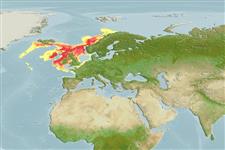Klassifizierung / Names
Namen | Synonyme | Catalog of Fishes(Gattung, Arten) | ITIS | CoL | WoRMS | Cloffa
Elasmobranchii (Haie und Rochen) (sharks and rays) >
Rajiformes (Skates and rays) >
Rajidae (Skates)
Etymology: Dipturus: Greek, di = two + Greek, pteryx = fin (Ref. 45335).
Environment: milieu / climate zone / depth range / distribution range
Ökologie
seewasser demersal; tiefenbereich 1 - 1500 m (Ref. 114953), usually ? - 200 m (Ref. 114953). Temperate; 49°N - 70°N, 32°W - 15°E (Ref. 114953)
Northeast Atlantic: Iceland to the British isles, it was formerly more widespread, including the Mediterranean Sea and North Africa, but its range is thought to be reduced due to fishing.
Size / Gewicht / Alter
Maturity: Lm ? range ? - ? cm
Max length : 285 cm TL Männchen/unbestimmt; (Ref. 114424); max. veröff. Gewicht: 113.0 kg (Ref. 114424)
Kurzbeschreibung
Morphologie | Morphometrie
Rückenflossenweichstrahlen (insgesamt): 0; Afterflossenstacheln 0; Afterflossenweichstrahlen: 0. This species is characterized by the following: snout long and pointed, length 3.7-5.1 times orbit length; disc broadly rhombic, anterior margin deeply concave; a row of 12-18 predorsal thorns in median row along tail (disc smooth in young); lateral thorns on tail pointed towards head; interspace between dorsal fins (2.4 ± 0.5 TL); upper surface dark olive-green in young with small pale spots, becoming greyish-brown; underside greyish or whitish; iris olive green (Ref. 114953, 127223).
A benthic species found in shelf and slope waters, mainly within the 200 m range but occasionally down to 1,500 m (Ref. 114953, 127218, 127220, 127222). Feeds on all kinds of bottom invertebrates and fish, including other skates (Ref. 114953). Oviparous, with long embryonic development. Males reach maturity at ca. 185 cm TL, females at 197 cm TL; birth size at ca. 29 cm TL, from large egg cases (up to 25 cm) (Ref. 114953). Biology unclear due to past taxonomic confusion.
Life cycle and mating behavior
Geschlechtsreife | Fortpflanzung | Ablaichen | Eier | Fecundity | Larven
Last, P.R., S. Weigmann and L. Yang, 2016. Changes to the nomenclature of the skates (Chondrichthyes: Rajiformes). In: Last and Yearsley (eds.). Rays of the World: Supplementary Information. CSIRO Special Publication. 11-34. (Ref. 118749)
IUCN Rote Liste Status (Ref. 130435)
Bedrohung für Menschen
Harmless
Nutzung durch Menschen
Mehr Information
NamenSynonymeMetabolismusRäuberÖkotoxikologieFortpflanzungGeschlechtsreifeAblaichenSpawning aggregationFecundityEierEientwicklung
Alter/GrößeWachstumLänge-GewichtLänge-LängeLängenhäufigkeitenMorphometrieMorphologieLarvenLarven Pop.Dyn.RekrutierungDichteBRUVS
ReferenzenAquakulturAquakultur ProfilZuchtlinienGenetikElectrophoresesVererbbarkeitKrankheitenVerarbeitungNutrientsMass conversion
PartnerBilderStamps, Coins Misc.LauteCiguateraGeschwindigkeitSchwimmstilKiemenoberflächeOtolithsGehirngrößeSehfähigkeit
Tools
Zusatzinformationen
Download XML
Internet Quellen
Estimates based on models
Phylogenetic diversity index (Ref.
82804): PD
50 = 0.5000 [Uniqueness, from 0.5 = low to 2.0 = high].
Bayesian length-weight: a=0.00282 (0.00133 - 0.00596), b=3.25 (3.08 - 3.42), in cm total length, based on LWR estimates for this Genus-body shape (Ref.
93245).
Trophic level (Ref.
69278): 4.1 ±0.6 se; based on size and trophs of closest relatives
Widerstandsfähigkeit (Ref.
120179): sehr niedrig, Verdopplung der Population dauert mehr als 14 Jahre. (Preliminary K or Fecundity.).
Fishing Vulnerability (Ref.
59153): Very high vulnerability (90 of 100).
